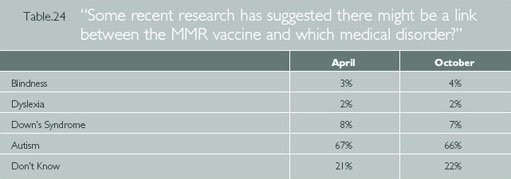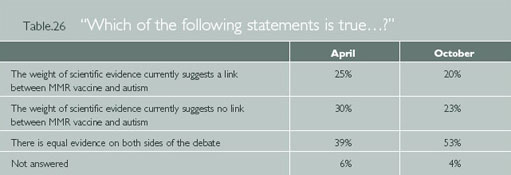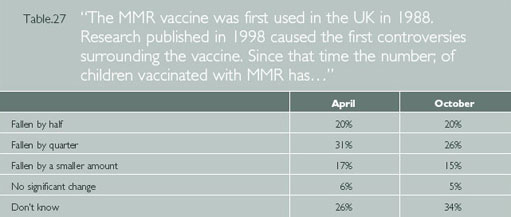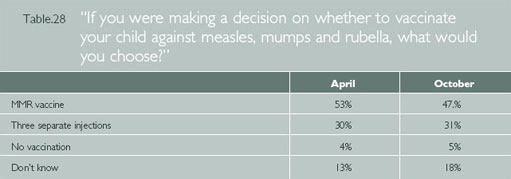10.8 The media and public understanding of the MMR controversy
Hargreaves, I., Lewis, J. and Speers, T. ‘Towards a better map: Science, the public and the media’, Economic and Social Research Council.
As we saw in the coverage of the story itself, the MMR issue is often compared to the BSE/CJD crisis, both stories involving potential risks to the public initially denied by both government and mainstream science. And there is no doubt that the BSE controversy framed much of the MMR coverage. Andrew Wakefield may be something of a voice in the wilderness, but, pitted against a phalanx of government officials and experts, journalists were also unwilling to discount the possibility that he may be right.
We found, first of all, that many of the key moments in the narrative did get across. Indeed, in many ways this story was the most successful of the three at communicating key themes. In particular, the specific link between MMR and autism was repeated in most stories on this issue, and most people (two out of three of our respondents in both surveys) were consequently aware of it.
Leo Blair's role in the story was also widely covered and widely known – producing one of the highest percentages of correct answers in both surveys (66 per cent in April and 70 per cent in October)3.
Quite why the Prime Minister's involvement produced such a high percentage of correct responses is less obvious. While mentioned in many stories (32 per cent in our sample overall), it was by no means the most prominent aspect of the coverage. It is possible that the human interest value of the Prime Minister's personal involvement in the story made this information more memorable. But we should not overlook the importance of Tony Blair's position in the story. For people confused about who to trust, this was an important indicator of the government's faith in its own position. In a nutshell, was the government's support for MMR deeply felt or merely tactical and strategic? Leo Blair might, therefore, be reasonably seen as a test of the government's confidence in its own position.
This point alerts us to the importance of narrative in communicating information. Tony Blair's involvement was significant because it came at a key stage in the narrative, made all the more compelling by the degree of suspense surrounding it4. If Leo Blair had been given the MMR vaccine, our findings suggest that the Prime Minister's refusal to disclose this information (while understandable on a personal level) was, in public health terms, a mistake. It kept open the possibility that the Prime Minister had reviewed the evidence and decided against the MMR jab, which can only have added to people's fears.5
As we have established, many media reports gave voice to both sides in the ensuing debate about the safety of the vaccine. This was sometimes a debate between scientists, and sometimes a debate between scientists or public health officials and concerned parents. The role of parents in this balancing act allowed anecdotal evidence from parents with autistic children to enter the discussion – which, while not authoritative as scientific evidence, is powerful rhetorically. Indeed, scientists or public health officials cannot have relished debating people who not only commanded immediate public sympathy, but whose own children were, apparently, testimony to the risks involved with vaccination.
If some media reports did point out that the weight of scientific evidence suggested the safety of MMR, this was not, apparently, the impression created by the coverage. When asked about the scientific evidence, many people (25 per cent in April, falling to 20 per cent in October) felt that Wakefield's speculative claim was actually backed (rather than contradicted) by most research, while the most popular response was to say that there was ‘equal evidence on both sides’.
This indicates that the traditional ‘balanced’ approach taken by many reports seems to have been what lingered in most people's minds: indeed, the impression of an equally divided body of research on the controversy hardened between April and October, rising from 39 per cent to 53 per cent. This increase of 14 per cent was the biggest overall shift in our knowledge index, and suggests a degree of confusion early on in the story, with the ‘balanced’ framework becoming more dominant as the story developed.
What we see here, once again, is a distinctive pattern of learning, whereby people absorb a dominant media framework, and then use it to make suppositions. So even where reporters spell out the relative weight of evidence, as this BBC report did:
“ parents… have to decide who to trust – either the vast array of medical experts here and abroad who are convinced MMR is safe or Dr Wakefield who has the vocal support of a minority of parents” (BBC News, 7th Feb, 2002).
What appears to get heard is merely that there are two bodies of evidence. In this instance, this encourages a movement away from both the correct answer and the most obviously incorrect answer, and towards a misleading and decidedly uncertain middle ground.
Another often repeated aspect of the story – the idea that the take up of MMR was falling fairly rapidly – also seems to have hit home. When asked how much take up was falling (at a time when evidence suggested a fairly small overall decline), a plurality overestimated, with less than one in six people giving the correct response. Once again, this suggests that people are not necessarily responding to the details of media content – claims about the overall decline were rarely technically inaccurate – but to a simpler association in which the repetition of the theme of declining take-up (the third most prominent theme in our sample of the coverage) led to an assumption over-estimating that decline.
We do not know, as yet, what the longer-term implications of this story are for the decline in take-up of the MMR vaccine, although our survey offers some clues. When respondents were asked what choice they would make, about half opt for the MMR vaccine. For many respondents, of course, this is merely a hypothetical choice. Nevertheless, this does suggest that while it remains the most popular option, there has been a serious loss of confidence in the vaccine. The decline from 53 per cent in April to 47 per cent in October is, perhaps, a particularly worrying trend for public health professionals.
The ‘separate vaccines’ option – the second most recurrent theme in media coverage – is the most popular alternative, favoured by around a third of respondents in both surveys.6
What lessons might be leaned from this? Journalists clearly felt that they acting in the public interest, while the desire to question officialdom, in whatever form it takes, is manifestly a healthy one. And the popularity of the ‘separate vaccines’ option suggests that journalists were aware of the public health risks of non-vaccination.
The problem, in retrospect, was that the debate was not, on the whole, about the key scientific aspects of the controversy. The fact that the empirical evidence provided by Dr Wakefield did not involve the vaccine at all (implicating the measles virus, not the MMR combination) received very little discussion. In short, the subsequent publicity given to the single vaccine occurred despite there being no empirical evidence to support it. The use of anecdotal evidence from a selective (and unrepresentative) group of parents might also be regarded as unhelpful for such an important matter of public policy.
These points matter, because the coverage clearly shaped the way many people understood the issue, and appears to have led to a loss of confidence in the vaccine in Britain – while confidence remains high elsewhere. And the public health consequences of an increase in measles, mumps and rubella infections are very serious indeed.7
Given the risks involved following a loss in public confidence, should journalists subject the claims of maverick scientists like Wakefield to more scrutiny before reporting them? This raises a more general question about the coverage of science, which we put to people in our October survey.
Perhaps surprisingly, nearly half felt that when scientists go against the grain (as Wakefield has), the media should wait until other studies confirm those findings before covering it. This reticence may seem odd, particularly since this issue does not involve issues of privacy, and since such work may already be in the public domain through publication in reputable journals. But it speaks to the degree to which many people feel the need for expert guidance on scientific issues. As this parent put it, writing in The Sunday Times (on February 10th): ‘I hadn't gone on the internet and surfed my way across every single website on MMR. I don't have a science degree either, so I hadn't read every study ever published in a medical journal.’ The choice, for her, came down to trusting advice from her GP, who she felt was in a better position to evaluate the evidence than she was.
This brings us, perhaps, to the difficulty at the heart of coverage of a health scare like MMR. The story appears to have created doubts in many people's minds about the safety of the MMR vaccine. And yet, unlike a decision to avoid beef, eggs or any other ‘suspect’ foodstuffs, avoiding the MMR vaccine increases the risk of potentially harmful disease. It was difficult, in this context, for most parents to know what to do for the best (other than opt or campaign for single jabs, a solution without any empirical evidence to justify it) or who they might to seek guidance from. Tony Blair's refusal to disclose his own decision on MMR, in this context, made the gap between confusion and guidance much more difficult. While for many science stories this might not be a problem, in this case there are direct consequences for public health.
For the purposes of this study, however, what is striking is how successfully the main themes of the media coverage formed the building blocks for public understanding. This was not, after all, a major, headline grabbing story. Yet the consistency of the coverage, the coherence of the narrative, and the connection to a broader public interest made much of it memorable – a point we shall take up later in the Conclusion.
3Because this question is not, strictly speaking, knowledge of science or science related policy, it was not included in our public understanding index.
4 See Lewis, 1991, for an analysis of the importance of narrative codes in communicating news.
5 One should not forgot, of course, the way in which John Gummer's attempt to assuage fears about beef by feeding his children burgers during the BSE crisis appeared to backfire. The Prime Minister's standing and image is, however, probably more credible and authoritative.
6 Although it is worth adding that respondents were not asked to pay more for this option.
7 A point graphically made in February 2002 by Dr Liam Donaldson, the Chief Medical Officer, and later by a science museum exhibition and website on the issue.






